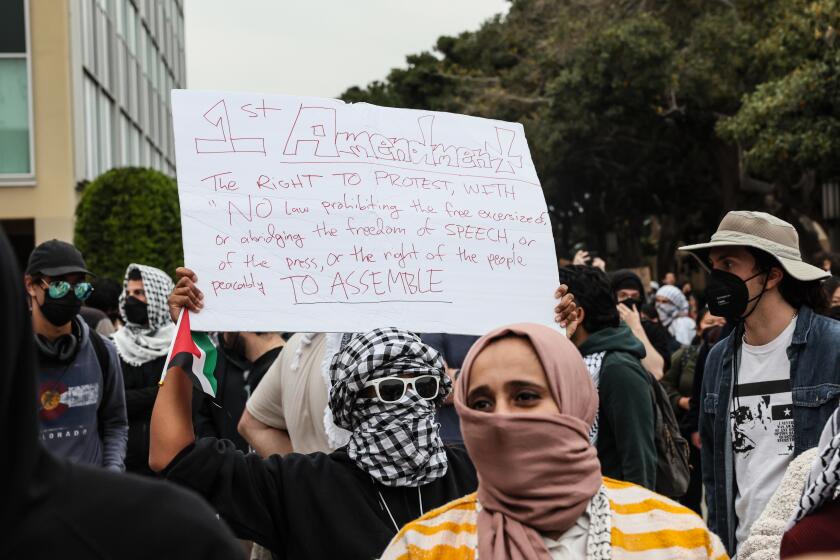A Formula for Math and Science Teachers : Education: Former aerospace workers are enrolled in a pioneer program designed to reduce the shortage of qualified instructors.
Jerry Young of Torrance, a retired aerospace engineer, had his golf handicap about as low as it would go when he got a letter from his former employer, TRW Inc. in Redondo Beach.
Would Young, 60, be interested in a program to turn retired engineers into teachers?
“I hated to give up my free time. But it fit me so well I didn’t hesitate,” Young said.
So, a year after retirement, Young is a full-time college student, studying for his California teaching credential.
“This is my third life,” said Young, who was in the Air Force for 23 years before going to work for TRW.
Young and 17 other former aerospace workers are in the California Math and Science Teacher Corps Project, a pioneer effort to use some of America’s most learned brains to reduce the national shortage of math and science teachers.
The project, which started in 1990, is sponsored by Cal State Dominguez Hills and four of the Southland’s largest high-tech firms: Hughes, TRW, Rockwell International and McDonnell Douglas.
Participants spend a year on campus in a custom-designed teacher training program. If they pass the national math teachers exam at the end of the course, they will be credentialed.
Will Mullins of Manhattan Beach calls the teaching job he hopes to get “the most important career of my life.”
Mullins, 70, worked for 35 years on radar systems at Hughes Aircraft Corp. He retired five years ago and, as with many older couples, he and his wife, Violet, traveled and attended senior citizen seminars.
But when Mullins heard that Hughes would pay for him to go back to college to become a teacher, he jumped at the opportunity.
“I love mathematics,” he explained, “and I would like to go back and recapture some of the early work I (did) in it and, perhaps, excite a few youngsters along the way.”
Corporate sponsors recruit from among their retired or soon-to-be retired employees and pay for tuition and books for each person.
At 71, Jerome Aristei of Palos Verdes Estates is the oldest participant.
“I’ve seen too many people retire and die,” Aristei said, explaining why he joined the corps when his former employer, Hughes, announced that it was recruiting.
Most participants are at least 55, but Diane Blindbury of Manhattan Beach, a former computer scientist, is the exception at 43. She is the youngest in the program.
Blindbury went to work for TRW when she got out of college, and five years ago took an extended leave to spend more time with her son and daughter, now 13 and 10.
“I always said I was going to teach math,” Blindbury said. When she heard about the teacher corps, she contacted TRW and the firm included her among the six people it is sponsoring.
“We were all totally shocked at the quality of the program,” Blindbury said.
She sings its praises even though the demanding curriculum means she bids her family good night around 9 o’clock every evening and stays up to study until after midnight.
As PTA president at her daughter’s school and a school volunteer, Blindbury was familiar with today’s schools. Yet she was surprised at the high quality of a teaching education.
At a cost of $4,000 per person, the corps is a bargain for corporations worried about their future work force. Rockwell, for example, has a “keen interest” in helping to improve elementary and secondary education because it is the pipeline for getting people into college math and science courses, said Mary Lou Kromer, the company’s director of advertising and communications.
The corps seems a bargain for the state of California too. Last year, there were at least 1,000 math teachers statewide with only emergency credentials, said Robert T. DeVries, a former administrator in the Los Angeles Unified School District and coordinator of the teacher corps project.
“These are teachers who are hired off the streets, who have (only a limited) academic background in math,” DeVries said.
Usually, these teachers have the minimum 20 units of lower-division college math, not the 30 units of upper-division math a certified math teacher must have, DeVries explained.
Joel Colbert, one of the Dominguez Hills education professors who are training the would-be teachers, said he expects them to be among the most valuable people ever to enter classrooms.
“They will be able to relate their actual job experiences . . . to the teaching of math and science and make it more relevant to the students,” Colbert said. “They’ve used the principles of math and science to actually design the things that interest students.”
All 18 corps participants are training to be math teachers. The program has not yet developed a curriculum for science teachers.
Rockwell and Dominguez Hills started the corps in 1990, but when only one of the first 11 participants went on to teach, they had to take stock and revamp the program.
The most significant change, in addition to getting three more corporate sponsors, was to set up a better screening process, DeVries said. For every person chosen, three were interviewed. The first group, DeVries said, was composed of mostly older retirees, some of whom turned out to have health problems and most of whom had little idea what schools are like today.
This time around, ages are more varied and participants visit schools even before they start taking classes. And the curriculum has been tailored for people who were in school as long as 50 years ago, before education became multicultural and long before AIDS, drugs and computers became classroom topics.
“I haven’t done a calculus class since 1947,” said TRW retiree Roger Mills, 67, of Rancho Palos Verdes.
One of the most difficult classes, participants say, is their three-hour math laboratory, which trains them to take the national math teachers exam.
“It’s our humility course,” Blindbury said.
She and her colleagues must retrace everything they ever learned in math and add to it the explosion of knowledge that has occurred in the last two or three decades.
Before being admitted to the program, the applicants expressed an interest in making a contribution, said Linda Page, a former educator who coordinates Hughes’ activities in local schools.
“The one common thread that runs through their remarks (about) why they’re doing this is that they want to give back, that life has been good to them and they’ve had some great experiences in math and technology and they want to share that,” Page said.
Patrick Kennedy of Tustin, who at 61 retired in January from Rockwell after 31 years, came to the United States from Ireland when he was 18.
“I feel this society has been very kind to me and there is a part of me that I owe it something,” Kennedy said. “I don’t mean to be patriotic or anything, but it’s a feeling.”
Kennedy, who is fluent in Spanish, believes that he will be most useful in a school with a large Latino population.
Jerry Young has been a volunteer tutor for years in programs aimed at minority youngsters and wants to teach in a district that caters to such children, he said.
“I want to see the promise of the United States fulfilled,” Young said, “that we have a fair and equal society and that all people have a fair chance at an education and (at) economic success.”
DeVries has no doubt that the new teachers will find jobs when they complete their studies. He contacted the 20 school districts in the Dominguez Hills service area, telling them that there will soon be a new batch of teachers.
“I heard back from 10 directly saying, ‘That’s great, we’re going to be needing some teachers and how can we be part of your program?’ ”






